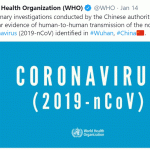WHO Claimed on January 14 that coronavirus could not be transmitted to humans because Chinese authorities found no clear evidence

Could the coronavirus outbreak have been prevented? This is the question a lot people have been asking. Sadly, the answer is probably “yes.” Let’s walk through the sequence of events to find how it all started. Yesterday, we published a story based on a report from South China Morning Post that the first case of coronavirus happened on November 17, 2019 when a 55 year-old from Hubei province contracted the virus. That was weeks before Chinese authorities announced the emergence of the new virus. Much of the outbreak could have been avoided if China was forthcoming from day November 17, 2019.
Ever since the first case, one to five new cases were reported each day. By December 15, the total number of infections stood at 27 – the first double-digit daily rise was reported on December 17 – and by December 20, the total number of confirmed cases had reached 60. Interviews with whistle-blowers from the medical community suggest Chinese doctors only realized they were dealing with a new disease in late December.
Then on January 14, the World Health Organization (WHO) said that the virus couldn’t be transmitted between humans. In a tweet post WHO said: “Preliminary investigations conducted by the Chinese authorities have found no clear evidence of human-to-human transmission of the novel #coronavirus (2019-nCoV) identified in #Wuhan, #China🇨🇳. pic.twitter.com/Fnl5P877VG— World Health Organization (WHO) (@WHO) January 14, 2020.”
Preliminary investigations conducted by the Chinese authorities have found no clear evidence of human-to-human transmission of the novel #coronavirus (2019-nCoV) identified in #Wuhan, #China🇨🇳. pic.twitter.com/Fnl5P877VG
— World Health Organization (WHO) (@WHO) January 14, 2020




